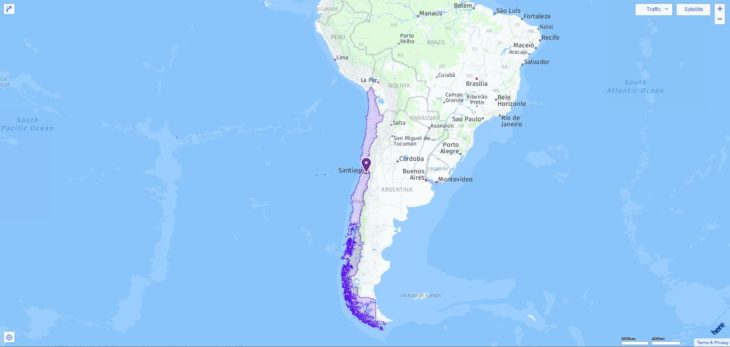Your search found 2 matches. The following is the full list of ACT testing locations in Chile among which you can pick one to take the exam. Please know that on the test day, test takers can use any 4-function, scientific, or graphing calculator. On the table below, you can also find all test dates through 2019.

2019-2020 ACT Test Dates in Chile
| Test Date | Registration Deadline |
| February 9, 2019 | January 11, 2019 |
| April 13, 2019 | March 8, 2019 |
| June 8, 2019 | May 3, 2019 |
| July 13, 2019 | June 14, 2019 |
| September 14, 2019 | August 16, 2019 |
| October 26, 2019 | September 20, 2019 |
| December 14, 2019 | November 8, 2019 |
| February 8, 2020 | January 10, 2020 |
| April 4, 2020 | February 28, 2020 |
| June 13, 2020 | May 8, 2020 |
| July 18, 2020 | June 19, 2020 |
ACT Test Centers in Chile
| City | Center Name | Center Code |
| Santiago | Intl School Nido De Aguilas | 865960 |
| Santiago | Santiago College | 865010 |
More about Chile
Chile borders Peru in the north, Bolivia in the northeast and Argentina in the east.
The surface shape is determined by the high cordillera in the east, the coastal cordillera in the west and the tectonically created longitudinal depression (large longitudinal valley) that extends in between. Northern Chile (Great North) is occupied by the Atacama Desert, which is joined to the south by the semi-arid Little North.
Law
At the top of the jurisdiction is the Supreme Court with extensive powers of control over the lower courts. The judges are appointed by the President on the basis of the lists of proposals of the higher court in each case; the 21 Supreme Court justices must be ratified by the Senate. The Constitutional Court examines, among other things. the constitutionality of laws, ordinances and referendums and decides on the prohibition of unconstitutional parties. – The Civil Code of 1857 is the work of the Venezuelan-Chilean lawyer, diplomat and writer A. Bello . It contains many influences from French law, but is an independent creation that has enjoyed high recognition worldwide and has had a lasting impact on the civil codes of numerous other Latin American countries.
Population
The population is relatively homogeneous and consists of around 75% mixed descendants of whites and indigenous peoples and 14% whites. The proportion of the indigenous population (mostly Mapuche, few Aimara) is around 11%. After the immigration of the Spaniards during the colonial period, there was only significant immigration in the 19th century (around 100,000 immigrants; in addition to southern Europeans, central and western Europeans were also involved, especially Germans in the southern lake area, in Valdivia, Osorno and Puerto Montt). – With an average (2017) of 24 residents / km 2Chile is only sparsely populated. However, the population distribution is very uneven. In the summer-dry central zone of central Chile, almost 80% of the total population live on 15% of the national territory; the north, the south and the high mountain regions are almost uninhabited. The largest metropolitan areas are the metropolitan areas of Greater Santiago, Greater Valparaíso (with Viña del Mar) and Greater Concepción (with Talcahuano).
The influx of the rural population into the urban centers continues unabated and leads to the growth of the poor areas (“poblaciones”). The share of the urban population is 90% (2017).
The biggest cities in Chile
| Biggest Cities (Residents 2017) | |
| Santiago *) | 6 160 000 |
| Valparaíso *) | 901 500 |
| Concepción *) | 723 000 |
| La Serena *) | 402,000 |
| Antofagasta | 352 600 |
| *) Agglomeration | |
Social: The social structure of Chile is characterized by a relatively broad middle class (mainly public and private employees). The country has one of the most comprehensive social security systems in Latin America (including pension, unemployment and health insurance). The health system is partly private, partly state-organized and offers free basic care for needy sections of the population.
Religion
The constitution guarantees freedom of religion. A state church in the legal sense ceased to exist in 1925. Traditionally, however, the Catholic Church, as the largest religious community, has a prominent position in public life.
According to the most recent diverging estimates, between 49 and 61% of the population belong to the Catholic Church (five archbishoprics and one Apostolic Vicariate in southern Chile), and between 9 and 17% belong to Protestant churches and communities. Deviations in the counting of (post-) Reformation faith groups also result from the selection of the denominations included. The minorities with a Christian background include the Jehovah’s Witnesses (approx. 1%), the Adventists (approx. 0.5%) and the Mormons (approx. 0.4%). The largest non-Christian religious communities are the Jews and the Baha’is. Traditional beliefs have been preserved among parts of the Indian population. Between 19 and 36% of the population are considered to be religious or non-religious.
Climate
As it extends over 39 degrees of latitude, Chile is climatically divided into the extremely dry subtropical desert zone of northern Chile with a foggy coast, northern central Chile with subtropical winter rain, southern central Chile with cool, moderate winter rain and southern Chile with rich rainfall in all seasons and low summer temperatures.

